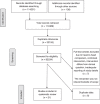Procedural and Physical Interventions for Vaccine Injections: Systematic Review of Randomized Controlled Trials and Quasi-Randomized Controlled Trials
- PMID: 26352919
- PMCID: PMC4900423
- DOI: 10.1097/AJP.0000000000000264
Procedural and Physical Interventions for Vaccine Injections: Systematic Review of Randomized Controlled Trials and Quasi-Randomized Controlled Trials
Abstract
Background: This systematic review evaluated the effectiveness of physical and procedural interventions for reducing pain and related outcomes during vaccination.
Design/methods: Databases were searched using a broad search strategy to identify relevant randomized and quasi-randomized controlled trials. Data were extracted according to procedure phase (preprocedure, acute, recovery, and combinations of these) and pooled using established methods.
Results: A total of 31 studies were included. Acute infant distress was diminished during intramuscular injection without aspiration (n=313): standardized mean difference (SMD) -0.82 (95% confidence interval [CI]: -1.18, -0.46). Injecting the most painful vaccine last during vaccinations reduced acute infant distress (n=196): SMD -0.69 (95% CI: -0.98, -0.4). Simultaneous injections reduced acute infant distress compared with sequential injections (n=172): SMD -0.56 (95% CI: -0.87, -0.25). There was no benefit of simultaneous injections in children. Less infant distress during the acute and recovery phases combined occurred with vastus lateralis (vs. deltoid) injections (n=185): SMD -0.70 (95% CI: -1.00, -0.41). Skin-to-skin contact in neonates (n=736) reduced acute distress: SMD -0.65 (95% CI: -1.05, -0.25). Holding infants reduced acute distress after removal of the data from 1 methodologically diverse study (n=107): SMD -1.25 (95% CI: -2.05, -0.46). Holding after vaccination (n=417) reduced infant distress during the acute and recovery phases combined: SMD -0.65 (95% CI: -1.08, -0.22). Self-reported fear was reduced for children positioned upright (n=107): SMD -0.39 (95% CI: -0.77, -0.01). Non-nutritive sucking (n=186) reduced acute distress in infants: SMD -1.88 (95% CI: -2.57, -1.18). Manual tactile stimulation did not reduce pain across the lifespan. An external vibrating device and cold reduced pain in children (n=145): SMD -1.23 (95% CI: -1.58, -0.87). There was no benefit of warming the vaccine in adults. Muscle tension was beneficial in selected indices of fainting in adolescents and adults.
Conclusions: Interventions with evidence of benefit in select populations include: no aspiration, injecting most painful vaccine last, simultaneous injections, vastus lateralis injection, positioning interventions, non-nutritive sucking, external vibrating device with cold, and muscle tension.
Conflict of interest statement
Supported by Canadian Institutes of Health Research (CIHR), Ottawa, Ontario, Canada (KRS 132031). Open access funding was provided by the Mayday Fund in the United States. A. Taddio declares a grant from Pfizer, and study supplies from Natus and Ferndale. C.T. Chambers declares consultation fees from Abbvie. E. Lang is a member of the GRADE working group and declares consultation fees from the International Liaison Committee on Resuscitation (ILCOR). L. Bucci declares a relationship with government agencies and grants from Merck, GSK, Novartis, Sanofi, and Pfizer. S.A. Halperin declares grants from GSK, Sanofi, Novartis, Pfizer, Merck, PREVENT, ImmunoVaccine, NovaVax, Janssen, and Folia. The remaining authors declare no conflict of interest.
References
-
- Taddio A, Ilersich AL, Ipp M, et al. Physical interventions and injection techniques for reducing injection pain during routine childhood immunizations: systematic review of randomized controlled trials and quasi-randomized controlled trials. Clin Ther. 2009;31(suppl 2):S48–S76. - PubMed
Publication types
MeSH terms
Grants and funding
LinkOut - more resources
Full Text Sources
Medical


